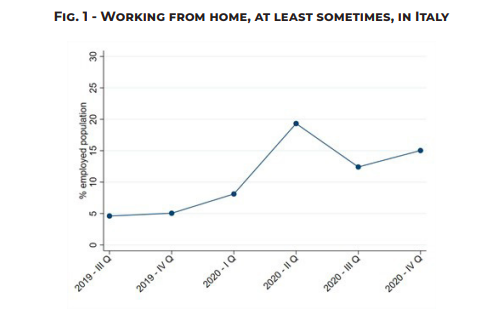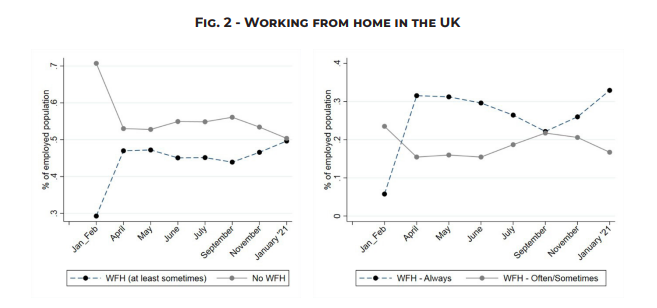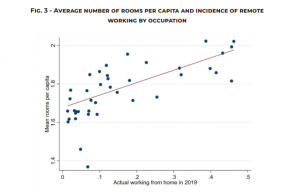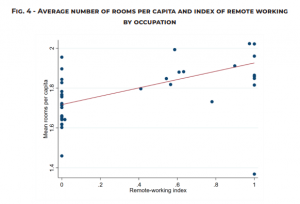The increased use of remote working will not completely fade away after the defeat of COVID-19. This structural change in production presents numerous challenges, of which the unequal distribution of housing conditions across individuals is of the utmost importance, as it creates new sources of inequality both in current earnings distribution (pay differences across workers who would be equally productive under the same working conditions) and in terms of career opportunities. In this Policy Brief, we firstly stress the need for better data collection to monitor housing conditions among remote workers. We then propose seven different policy strategies for G20 countries: i) investments in hybrid housing-working spaces, ii) providing good Internet connections to everybody, iii) international co-ordination in regulating remote working, iv) regulation of remote working and decentralisation of collective bargaining, v) family policies for the sharing of care responsibilities, vi) urban planning and coordination in the supply of decentralised co-work sites, and vii) prevention of possible new forms of discrimination.
Challenge
During the pandemic, the share of jobs carried out remotely (mostly from home) increased by a factor of three to four in most developed countries, rising from around 10% to 30-40% of the workforce (Morikawa 2020). The spread of remote working was rapid, massive and unprecedented. Besides, it was unequally distributed, as workers’ ability to work from home differs greatly depending on their socio-demographic and economic status (Basso et al. 2020). There are reasons to believe that the labour market after Covid-19 will continue to offer a significant portion of remotely organised jobs, as highly indebted firms are likely to cut down on fixed costs such as office space rent (Baldwin 2020). Surveys of employers and employees carried out during the pandemic consistently indicate an irreversible shift towards a hybrid system, with a significant role played by working from home (Bartik et al. 2020; Bloom et al. 2021). They also suggest that remote work will likely be limited to a few days a week, as working fully from home can harm productivity (Bloom, 2020). At the same time, the improvement of working from home (WFH) technologies during the pandemic has dramatically increased the productivity of remote working as these technologies are very much dependent on the prevalence of adoption (Davis et al. 2021).
Some indications as to future developments in the incidence and organisation of remote working come from the analysis of its evolution between the first two waves of the pandemic. Figure 1 shows the evolution of workers declaring that they work at least sometimes from home, based on Labour Force Survey data for Italy. The percentage of employees working from home increased from roughly 5% in 2019 to 20% in the second quarter of 2020. Importantly, it did not return to pre-pandemic levels even during the summer, when most restrictions were lifted and many Italians were convinced that the pandemic was over.

Note: This graph plots the evolution of the percentage of employed workers in Italy who declare that they work at least sometimes from home. IT-LFS data.
Unfortunately, LFS data do not often provide information on the housing conditions of remote workers. Data from the Understanding Society COVID-19 survey offer better information on the extent of working from home among the working age population, and can be also linked to previous data on housing conditions, but they unfortunately cover the UK only.
As can be seen in the left-hand panel of Figure 2, in April 2020, around 47% of the workforce declared that they work from home at least sometimes, up from 30% in January and February of the same year, i.e. before the spread of the COVID-19 virus. The incidence of remote working slightly decreased in the following months as the number of daily new cases of Coronavirus had halved from its initial peak, and then increased again in November, in conjunction with the second lockdown faced by the country. Interestingly enough, in between the two waves of the epidemic, the share of workers always working from home declined while the share of employees working from home often or sometimes increased (right-hand panel of Figure 2). In particular, between April and September 2020, the percentage of workers always operating remotely declined from around 32% to 22%, while the percentage of workers operating often or sometimes from home rose from around 15% to around 22%. This may suggest that the “new normal” scenario after the most acute phase of the pandemic will be one of hybrid working organisations with the coexistence of work at home and in the office.

Note: The graph in the left-hand panel plots the evolution of the percentage of employed workers who declare that they work at least sometimes from home, compared to that for those who do not. The graph in the right-hand panel plots the evolution of the percentage of employed worker who declare that they always work from home along compared to for those who do so often or sometimes. Understanding Society Covid-19 data.
This change in the organisation of work poses numerous challenges in terms of productivity, urban development, infrastructure capability, social relations, workers’ safety and well-being. Income inequality may increase not only due to the large number of jobs that can or cannot be carried out from home, but also as a result of the large amounts of time devoted to remote working and the conditions under which this takes place.
The unequal distribution of housing conditions across individuals is indeed of the utmost importance in these developments, as the quality of housing and home fungibility, notably the possibility to transform bedrooms into office space during the day, are essential elements of remote workers’ well-being and productivity. As residential spaces become workplaces, some workers will be penalised in their performance with respect to others for reasons that are largely independent of their skills and commitment to work. In other words, the spread of remote working will create a new and relevant obstacle to social mobility: housing inequality.
Housing conditions are often perceived as problematic by remote workers. Poor working from-home setups and poor telecommunication environments at home compared to the workplace were major reasons for the decrease seen in productivity at home in Japan (Morikawa 2020; Kitagawa et al. 2021). Management and psychology literature stresses the fact that workers’ isolation may also have negative effects on productivity due to interference between work and family responsibilities (Taskin and Bridou, 2010; Rockmann and Pratt, 2015).
The challenge of housing quality and inequality in a remote working world is common to all G20 members, as the reshaping of production processes is taking place over all developed countries. However, governments are unprepared to deal with this new source of inequality and social immobility. Actions should be devised at the border between the labour market and housing policies, as suggested below.
Proposal
MEASURE HOUSING INEQUALITY AMONG REMOTE WORKERS
Housing policies are a key policy area, even more so in the post-pandemic world. Yet, very little attention has been traditionally devoted to it. The present Policy Brief is the first to address it within the T20 engagement group. The G20 offers the best forum to discuss the problems related to remote working and housing inequality and to find concrete solutions. Some actions require international coordination; others are a domain of experimentation and G20 countries can learn from their national experiences.
Firstly, G20 governments should monitor carefully the interactions between the spread of remote working and housing inequality. Measuring housing conditions in the context of remote working requires a multidimensional approach. It is important to consider the following dimensions:
- Structural conditions: e.g. the number of rooms available, convertibility of bedrooms or living rooms into office spaces, soundproofing insulation from neighbours, lighting, etc.;
- Working tool related conditions: e.g. the availability of digital devices, an Internet connection, a comfortable desk and an ergonomic chair;
- Family conditions: e.g. the presence of dependent people (small children, elderly or disabled relatives) requiring care.
Focusing on the first dimension, there are indications that, before the COVID-19 pandemic, remote workers had, on average, a larger number of rooms per capita and, more broadly, better housing conditions than workers operating at the workplace only. This can be related to two different mechanisms: i) remote workers investing more resources in housing conditions; ii) self-selection into remote working by individuals benefitting from a relatively good work environment at home.
Concerning the first mechanism, Stanton and Tiwari (2021) use data on the US prior to the pandemic and find that the average renting household with at least one adult who works remotely spent between 6.5% and 7.4% more of their income on housing compared to similar non-remote working households. Among owners, mortgage payments and property taxes as a share of household income were between 8.4% and 9.8% greater for remote working households. Besides, the authors highlight that prior to the COVID-19 pandemic, remote working households occupied 0.3 to 0.4 more rooms per dwelling, which is between a 5% to 7% increase in space relative to non-remote working households.
As far as the second mechanism is concerned, before the pandemic, remote working was, most of the time, a voluntary choice of workers. Matters changed during the pandemic as many workers were actually forced to work from home either by government policy or through fear of contagion: as a result, remote working was no longer associated with better working environments at home. After the pandemic, hybrid configurations are likely to prevail in which firms to save on fixed costs will ask workers to spend part of the week at home.
Figure 3 displays the average number of rooms1 per household member and the percentage of workers operating remotely by occupation (defined at ISCO-2 digits) in the European Union before the pandemic, based on EU-SILC data (for housing information) and EU-LFS data (for remote working). There is a positive correlation between the two variables: more remote working is associated with a higher number of rooms per capita. This is confirmed also by looking at the correlation between the number of rooms per capita and an index of potential remote working (see Basso et al. 2021 for details), which captures the potential for remote working by looking at the intrinsic task content of each occupation (Figure 4).

Note: This figure displays the relationship between the average number of rooms per capita available to workers and the percentage of employees declaring that they work from home at least sometimes, in the EU, for 2-digit ISCO occupational codes. Each dot corresponds to one of the 2-digit ISCO occupations. The linear fit is weighted by the number of workers in each occupation. Rooms per capita data are from EU-SILC (2018). Working from home percentages are from EU-LFS (2019).

Note: This figure displays the relationship between the average number of rooms per capita available workers and the percentage of employees who can work from home according to the potential remote working index of Basso et al. (2021) in EU countries. Each dot corresponds to one of the 2-digit ISCO occupations. The linear fit is weighted by the number of workers in each occupation. Rooms per capita are from EU-SILC (2018) data.
To obtain better information, we need to rely on surveys that provide simultaneously information on remote working and housing conditions at the individual level. The Understanding Society Covid-19 survey is once again useful in this respect. Figure 5 below compares the distribution of rooms per capita available among remote workers in April 2020. The grey bars refer to workers who were already working remotely in January and February (the “already WFH workers”), while the empty bars refer to those who started doing so in April (the “new WFH workers”). There is a visible difference in the two distributions, with higher fractions of new remote workers having between 1 and 2 rooms per capita. Consistently with this difference, the overall median number of rooms available to remote workers was 1.75 in April from 2 in January-February 2020. This suggests that there may be serious problems of housing adequacy for remote working as individuals are forced to work from home at least for parts of the week.

Note: This figure shows the distribution of the average number of rooms available per capita in the UK for workers who declare that they always work from home in April 2020. The grey bars refer to workers who were already working remotely in January and February, while the empty bars those who started doing so in April. Source: Understanding Society Covid-19 data.
IMPLEMENT BETTER DATA COLLECTION SYSTEMS
As the above suggests, it is very important to improve data collection by carrying out surveys that provide information on remote working and housing conditions at the individual level. Such data are essential to measure the wellbeing of individuals and to understand the consequences of the shift to remote working. Current surveys carried out by most national statistical offices include either information on housing conditions or on the extent of home working, rather than on both features for the same individual. Moreover, there is scope for improvement in the way in which information on housing conditions is elicited. Differences currently exist between countries in how rooms are defined, in particular the treatment of kitchens, and in how minimum space restrictions are applied. Information on housing quality, e.g. in terms of the provision of living space and the presence of damp, mould and leaks is not obtained in a consistent way across international data sources (OECD 2020).
TACKLE HOUSING INEQUALITY: A 7-ACTION STRATEGY
1. INVESTMENTS IN HYBRID HOUSING-WORKING SPACES
Residential planning should acknowledge the fact that there is no longer a well-defined divide between residential and office use in real estate. This means that fiscal incentives for housing renovation and broadband connections, notably in peripheral areas and in disadvantaged urban neighbourhoods, are likely to pay off in terms of increased productivity. National plans for recovery and resilience being developed in the EU, for instance, could interpret the emphasis placed on the digital transformation by the European Commission as encouraging investment in improving the organisation of work from home.
2. GOOD INTERNET CONNECTIONS FOR ALL
Governments should make sure that all persons of working age have access to good Internet connections. Due to the importance that these connections have for current working conditions, differences in Internet access may give rise to forms of discrimination among workers and further reduce equality of opportunity.
3. INTERNATIONAL COORDINATION IN ENFORCING LEGISLATION
Remote working makes it possible, in principle, to carry out activities anywhere, as in the case if call centres. The G20 should therefore seek a coordinated approach to the enforcement of national legislation. To some extent, remote working poses the same problems addressed by the EC Posted Workers Directive in the presence of broad differences in national regulations concerning working conditions and possibly pay (e.g. variations in the legal minimum wage).
4. REGULATION OF REMOTE WORKING AND DECENTRALISATION OF COLLECTIVE BARGAINING
While there is a large body of legislation governing workplace conditions, remote working conditions often lack a proper regulatory framework. Hence, public regulation has to evolve in order to take into consideration individuals’ housing conditions relevant to the work relationship. At the same time, it is important that regulation, while aimed at safeguarding workers and improving their well-being, does not stifle innovation and does not entail an excessive burden on firms.
Cost sharing between firms and workers is key. Stanton and Tiwari (2021) indicate that remote working households need more space to accommodate working from home. As a result, remote work entails a transition from firms’ financing of office space to household financing of home workspaces. To quantify the cost of expanding remote work for the marginal household, the authors estimate that bottom decile households would require between a 10-15% earnings premium to compensate for these extra costs, while households between the 80th and 90th percentile of income would require about a 3% earnings premium, and households in the top decile would not require additional compensation to offset housing expenses.
A good principle is to adopt broad, encompassing, but at the same time soft legislation that provides significant scope for bargaining over the specific details of work organisation under different conditions. The regulation of the Health and Safety risks of working from home needs to be addressed together with rules about the sharing of costs between employers and employees in the adaptation of dwellings for use as working space, e.g. in terms of Internet connections, digital devices, chairs and desks one of the three main dimensions of housing inequality when it comes to remote working. During the first wave of Covid-19, many workers spontaneously made use of their personal devices and of their personal Internet subscriptions for work purposes: this situation has to be stigmatised as strictly emergency-related and firms have to move to provide their employees with appropriate remote working tools.
Unions and employers’ associations are called on to play a major role in this transformation of the organisation of work. Collective bargaining must be decentralised in order to efficiently improve remote working. A centralised approach to the issue inevitably fails to take account of specific working conditions in individual firms.
5. REMOTE WORKING AND THE SHARING OF CARE RESPONSIBILITIES
Before the COVID-19 outbreak, employed women were more likely to work from home than employed men. 2 During the pandemic, the WFH gender gap among employed workers increased (Farré et al. 2020). As firms offer more WFH opportunities, we may expect that the increase in WFH persists among women. This positive remote working trend may stimulate higher labour market participation among women, with stronger effects in the countries that are lagging behind in this respect. As stated in Alon et al. (2021), “Work flexibility in general and telecommuting in particular are associated with a more equal division of childcare duties among mothers and fathers, thereby lowering the conflict for mothers between having a family and a career. Hence, if the future workplace indeed is more flexible, the motherhood penalty should shrink and so should overall gender inequality in the labour market”.
However, further attention should be devoted to the quality of WFH and to potential gender gaps in WFH quality. Both before and during the pandemic, WFH has been associated with simultaneous child caring responsibilities. For example, around 8% of hours worked at home are simultaneous with caring for children under the age of 13 (Braun et al. 2021). Simultaneous child caring activities may be detrimental to workers’ productivity at home and to their work satisfaction (Adams-Prassl 2021). During the COVID-19 lockdowns, although fathers and mothers both increased their WFH hours, the gender gap in time spent on caring for children increased (Farré et al. 2020, Andrew et al. 2021), raising concerns about gender gaps in WFH quality. It is therefore important to accompany the development of remote working with equal opportunity policies promoting a fair sharing of family responsibilities between members of a couple. For example, governments may encourage family policies that do not require the family home to be available for childcare during business hours.
6. URBAN PLANNING AND CO-ORDINATION IN THE SUPPLY OF DECENTRALISED CO-WORK SITES
The creation of decentralised co-working facilities can contribute to making remote working more sustainable both socially and environmentally. Co-work structures that offer office space notably to free-lancers and self-employed people already exist in many large conurbations. Further decentralisation is warranted to offer viable working environments to individuals who face difficult housing conditions. To be viable, these structures require a critical mass of interested individuals. Coordination across firms should therefore be pursued in creating decentralised co-working facilities that would minimise travel to work for those workers who find it difficult to work from home. Local government can play a very important role in this coordination.
The reduction of commuting due to increased use of remote working (combined with the spread of decentralised co-work sites) can contribute to a reduction in work injuries. In Italy, for example, injuries incurred while commuting represented 16% of the total in 2019, and this share was even higher for the service sector. In 2020, in the presence of severe lockdown measures for most of the year, a reduction of 38% was observed in the number of injuries incurred while commuting, including a 30% reduction in the number of fatal injuries.3 The reduction of commuting also reduces CO2 emissions. In countries like the UK and the US, the transport sector is now responsible for emitting more greenhouse gases than any other activity,4 including electricity production and agriculture. Globally, transport accounts for around a quarter of CO2 emissions.
7. PREVENT POSSIBLE NEW FORMS OF DISCRIMINATION
Housing conditions capable of reconciling residential and working conditions are bound to become a major asset in the future. There is a high risk, in this context, that employers may use housing as a way to discriminate among job applicants, just as the ownership of a motorcycle is often used as a requirement in the hiring of food delivery workers. Anti-discrimination and privacy regulations should address this issue, for instance by not allowing employers to elicit information on housing conditions from potential and actual job applicants.
Measures improving young people’s access to home mortgages are also warranted as it is important that remote working does not become another factor in reducing employment rates among school leavers and in forcing them to remain in the parental home.
NOTES
1 Excluding bathrooms, kitchens, corridors and entrance rooms, as in the EU-SILC data definition.
2 26% vs 22% in the US in 2019, as in Table 6 of the BLS economic release available at https://www.bls.gov/news.release/atus.t06.htm
3 https://www.inail.it/cs/internet/comunicazione/news-ed-eventi/news/news-dati-inail-infortuni-malattie-professionali-2020.html
4 https://www.epa.gov/ghgemissions/sources-greenhouse-gas-emissions
REFERENCES
Adams-Prassl A., (2021), The Gender Wage Gap in an Online Labour Market: The Costs of Interruptions, CEPR discussion paper DP14294
Alon T., S. Coskun, M. Dopeke, D. Koll, and M. Tertilt, (2021), From Mancession to Shecession: Women’s Employment in Regular and Pandemic Recessions, NBER Working Paper 28632
Andrew A., O. Bandiera, M. Costa Dias, and C. Landais, (2021), The careers and time use of mothers and fathers, The Institute for Fiscal Studies Deaton Review
Baldwin R., (2020), Covid, hysteresis and the future of work https://voxeu.org/article/covid-hysteresis-and-future-work
Bartik A.W., Z.B. Cullen, E.L. Glaeser, M. Luca, and C.T. Stanton, (2020), What jobs are being done at home during the covid-19 crisis? Evidence from firm-level surveys, NBER Working Paper 27422
Basso G., T. Boeri, A. Caiumi, and M. Paccagnella, (2021), Unsafe Jobs, Labour Market Risk and Social Protection
Bloom N., P. Mizen, and S. Taneja, (2021), Returning to the office will be hard https://voxeu.org/article/returning-office-will-behard/
Bloom N., P. Mizen, and S. Taneja, (2021), Working from home is revolutionising the UK labour market https://voxeu.org/article/working-home-revolutionising-uk-labour-market
Braun C., T. Cyronek, and P. Ruppert, (2021), On-the-Job Leisure and Working from Home: Measuring the Productivity at Work, Mimeo
Davis M.A., A.C. Ghent, and J.M. Gregory, (2021), The work-at-home technology boom and its consequences, NBER Working Paper 28461
De la Feira R. and A. Redonda, (2020), Tackling inequality through tax expenditure reforms, Policy brief, Task Force 4 – Social Cohesion and the State, T20, Saudi Arabia 2020
Farré L., Y. Fawaz, L. Gonzales, and J. Graves, (2020), How COVID-19 Lockdown Affected Gender Inequality in Paid and Unpaid Work in Spain, IZA discussion paper no. 13434
Kitagawa R., S. Kuroda, H. Okudaira, and H. Owan, (2021), Working from Home: Its Effects on Productivity and Mental Health, RIETI Discussion Paper Series 21-E-024
Morikawa M., (2020), Productivity of Working from Home during the COVID-19 Pandemic: Evidence from an Employee Survey, Discussion papers 20073, Research Institute of Economy, Trade and Industry (RIETI)
OECD, (2020), How’s Life? 2020: Measuring Well-being, Paris, OECD Publishing
Redonda A. et al., (2018), Tax expenditure and the treatment of tax incentives for investment, Policy brief, task Force – Trade, Investment and Tax Cooperation, T20, Argentina 2018
Rockmann K.W. and M.G. Pratt, (2015), Contagious offsite work and the lonely office: The unintended consequences of distributed work, Academy of Management Discoveries 1, pp. 150-64
Stanton C.T. and P. Tiwari, (2021), Housing consumption and the cost of remote work, NBER Working Paper 28483
Taskin L. and F. Bridou, (2010), “Telework: A challenge to knowledge transfer in organizations”, International Journal of Human Resource Management, vol. 21, pp. 2503-20








